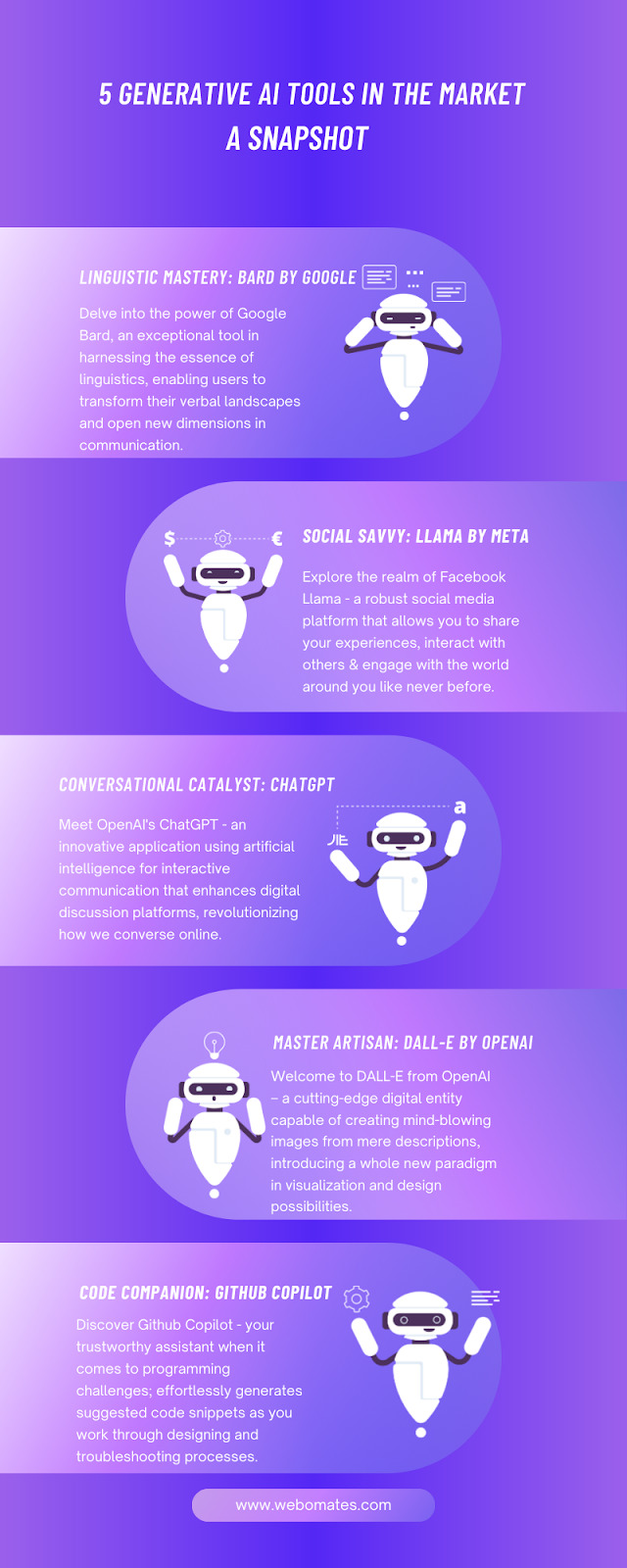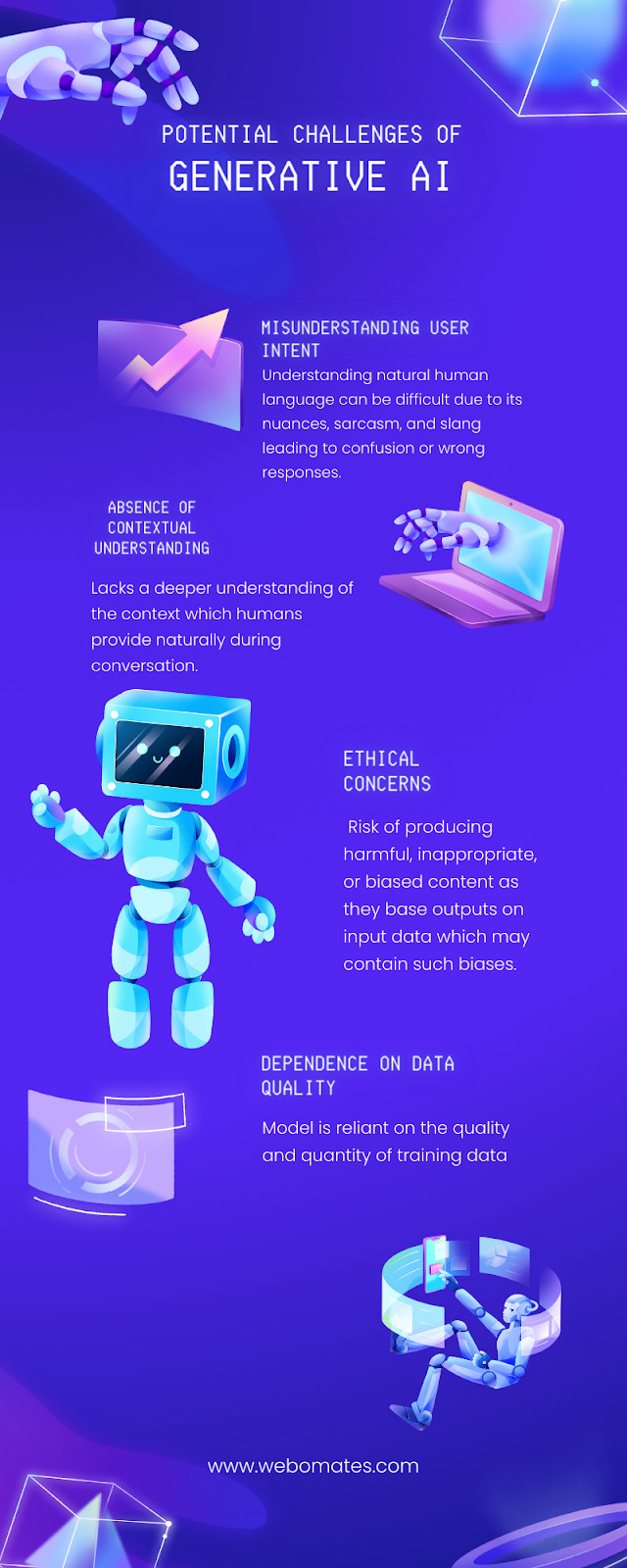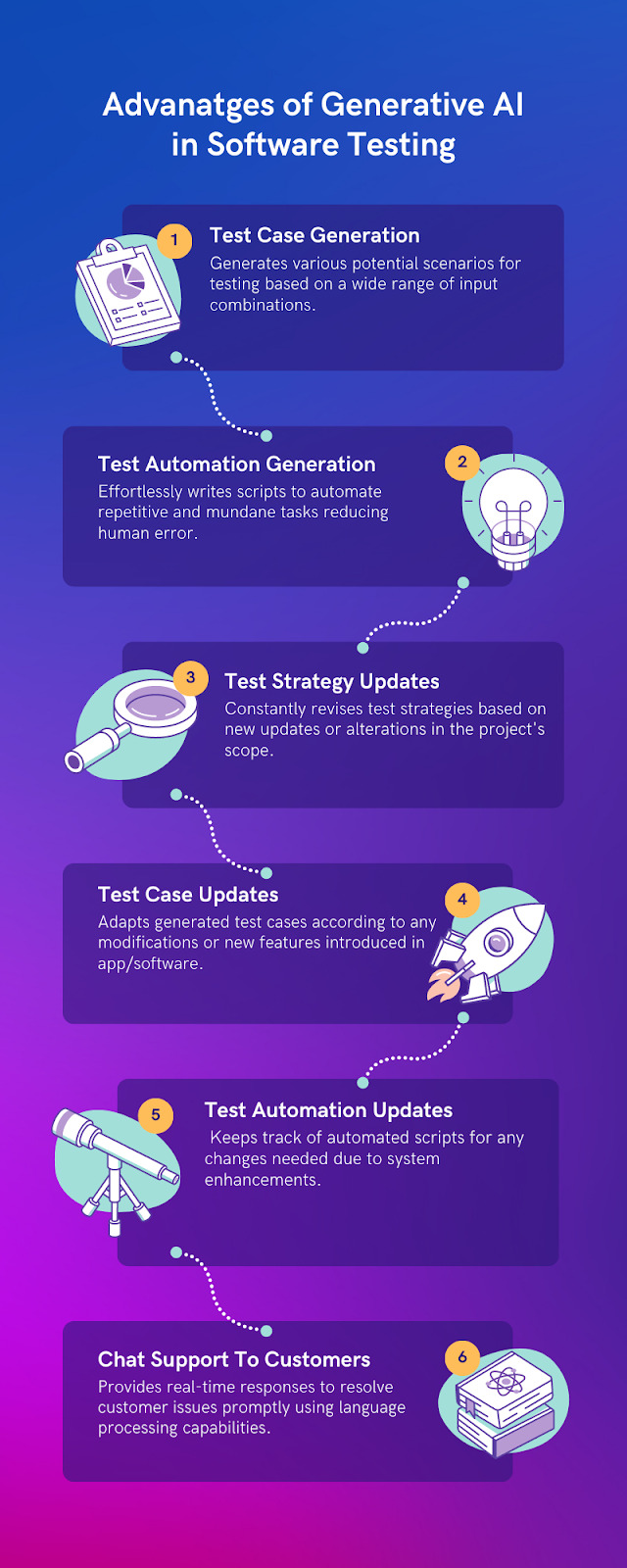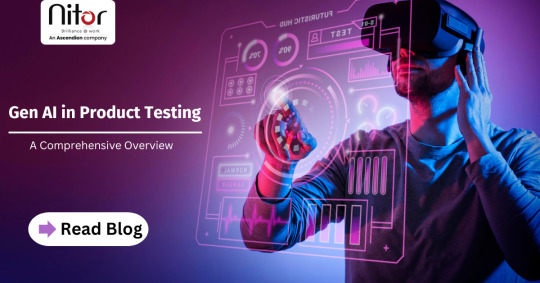#generative ai in software testing
Explore tagged Tumblr posts
Text
The Generative AI Revolution: Transforming Industries with Brillio
The realm of artificial intelligence is experiencing a paradigm shift with the emergence of generative AI. Unlike traditional AI models focused on analyzing existing data, generative AI takes a leap forward by creating entirely new content. The generative ai technology unlocks a future brimming with possibilities across diverse industries. Let's read about the transformative power of generative AI in various sectors:
1. Healthcare Industry:
AI for Network Optimization: Generative AI can optimize healthcare networks by predicting patient flow, resource allocation, etc. This translates to streamlined operations, improved efficiency, and potentially reduced wait times.
Generative AI for Life Sciences & Pharma: Imagine accelerating drug discovery by generating new molecule structures with desired properties. Generative AI can analyze vast datasets to identify potential drug candidates, saving valuable time and resources in the pharmaceutical research and development process.
Patient Experience Redefined: Generative AI can personalize patient communication and education. Imagine chatbots that provide tailored guidance based on a patient's medical history or generate realistic simulations for medical training.
Future of AI in Healthcare: Generative AI has the potential to revolutionize disease diagnosis and treatment plans by creating synthetic patient data for anonymized medical research and personalized drug development based on individual genetic profiles.
2. Retail Industry:
Advanced Analytics with Generative AI: Retailers can leverage generative AI to analyze customer behavior and predict future trends. This allows for targeted marketing campaigns, optimized product placement based on customer preferences, and even the generation of personalized product recommendations.
AI Retail Merchandising: Imagine creating a virtual storefront that dynamically adjusts based on customer demographics and real-time buying patterns. Generative AI can optimize product assortments, recommend complementary items, and predict optimal pricing strategies.
Demystifying Customer Experience: Generative AI can analyze customer feedback and social media data to identify emerging trends and potential areas of improvement in the customer journey. This empowers retailers to take proactive steps to enhance customer satisfaction and loyalty.

3. Finance Industry:
Generative AI in Banking: Generative AI can streamline loan application processes by automatically generating personalized loan offers and risk assessments. This reduces processing time and improves customer service efficiency.
4. Technology Industry:
Generative AI for Software Testing: Imagine automating the creation of large-scale test datasets for various software functionalities. Generative AI can expedite the testing process, identify potential vulnerabilities more effectively, and contribute to faster software releases.
Generative AI for Hi-Tech: This technology can accelerate innovation in various high-tech fields by creating novel designs for microchips, materials, or even generating code snippets to enhance existing software functionalities.
Generative AI for Telecom: Generative AI can optimize network performance by predicting potential obstruction and generating data patterns to simulate network traffic scenarios. This allows telecom companies to proactively maintain and improve network efficiency.
5. Generative AI Beyond Industries:
GenAI Powered Search Engine: Imagine a search engine that understands context and intent, generating relevant and personalized results tailored to your specific needs. This eliminates the need to sift through mountains of irrelevant information, enhancing the overall search experience.
Product Engineering with Generative AI: Design teams can leverage generative AI to create new product prototypes, explore innovative design possibilities, and accelerate the product development cycle.
Machine Learning with Generative AI: Generative AI can be used to create synthetic training data for machine learning models, leading to improved accuracy and enhanced efficiency.
Global Data Studio with Generative AI: Imagine generating realistic and anonymized datasets for data analysis purposes. This empowers researchers, businesses, and organizations to unlock insights from data while preserving privacy.
6. Learning & Development with Generative AI:
L&D Shares with Generative AI: This technology can create realistic simulations and personalized training modules tailored to individual learning styles and skill gaps. Generative AI can personalize the learning experience, fostering deeper engagement and knowledge retention.
HFS Generative AI: Generative AI can be used to personalize learning experiences for employees in the human resources and financial services sector. This technology can create tailored training programs for onboarding, compliance training, and skill development.
7. Generative AI for AIOps:
AIOps (Artificial Intelligence for IT Operations) utilizes AI to automate and optimize IT infrastructure management. Generative AI can further enhance this process by predicting potential IT issues before they occur, generating synthetic data for simulating scenarios, and optimizing remediation strategies.
Conclusion:
The potential of generative AI is vast, with its applications continuously expanding across industries. As research and development progress, we can expect even more groundbreaking advancements that will reshape the way we live, work, and interact with technology.
Reference- https://articlescad.com/the-generative-ai-revolution-transforming-industries-with-brillio-231268.html
#google generative ai services#ai for network optimization#generative ai for life sciences#generative ai in pharma#generative ai in banking#generative ai in software testing#ai technology in healthcare#future of ai in healthcare#advanced analytics in retail#ai retail merchandising#generative ai for telecom#generative ai for hi-tech#generative ai for retail#learn demystifying customer experience#generative ai for healthcare#product engineering services with Genai#accelerate application modernization#patient experience with generative ai#genai powered search engine#machine learning solution with ai#global data studio with gen ai#l&d shares with gen ai technology#hfs generative ai#generative ai for aiops
0 notes
Text
The Transformative Power of Generative AI in Software Development
Introduction
Generative AI, a cutting-edge technology that harnesses the power of artificial intelligence to create novel content, has revolutionized the software development landscape. From streamlining the testing process to enhancing user experiences, Generative AI has become an indispensable tool in the arsenal of modern software engineers. In this article, we will delve into the various applications of Generative AI in software development, exploring how it is shaping the future of the industry.
Generative AI for Testing
One of the most significant applications of Generative AI in software development is in the realm of testing. Generative AI-powered testing tools, such as GeneAIwiz, leverage machine learning algorithms to automatically generate test cases based on the software's requirements and specifications. This approach not only reduces the time and effort required for manual testing but also ensures a more comprehensive and thorough testing process. By simulating real-world scenarios and edge cases, Generative AI can identify potential issues early in the development cycle, leading to higher-quality software and reduced costs associated with post-release bug fixes.
Automated Test Case Generation
Generative AI algorithms can analyze software requirements and generate a vast number of test cases that cover various scenarios, including edge cases and corner cases. This automated approach ensures that no stone is left unturned during the testing process, leading to more robust and reliable software.
Intelligent Test Data Generation
Generative AI can also be used to generate realistic test data that mimics real-world user behavior and data patterns. By creating a diverse set of test data, Generative AI helps identify potential issues related to data handling, validation, and edge cases, ensuring that the software can handle a wide range of inputs and scenarios.
Continuous Testing and Integration
Generative AI-powered testing tools can be seamlessly integrated into the continuous integration and continuous deployment (CI/CD) pipeline, enabling developers to continuously test their code as it is being developed. This approach helps catch bugs early in the development cycle, reducing the time and effort required for debugging and rework.
Generative AI for User Experience Design
Generative AI is also making waves in the realm of user experience (UX) design. By analyzing user behavior, preferences, and feedback, Generative AI can help designers create more intuitive and engaging user interfaces. Generative AI-powered design tools can generate multiple design variations based on user preferences, allowing designers to quickly iterate and refine the user interface.
Personalized User Experiences
Generative AI can also be used to create personalized user experiences by analyzing user behavior and preferences. By tailoring the user interface and content to individual users, Generative AI can enhance user engagement and satisfaction, leading to higher user retention and loyalty.
Automated Design Generation
Generative AI can be used to automatically generate design elements, such as icons, illustrations, and color schemes, based on the project's branding and design guidelines. This approach can save designers significant time and effort, allowing them to focus on higher-level design tasks.
Generative AI for Code Generation
Generative AI is also making its mark in the realm of code generation. By analyzing existing code and project requirements, Generative AI can generate boilerplate code, templates, and even entire modules, reducing the time and effort required for manual coding. This approach can be particularly useful for repetitive tasks, such as creating CRUD (Create, Read, Update, Delete) interfaces or implementing common design patterns.
Intelligent Code Completion
Generative AI-powered code editors can suggest relevant code snippets and completions based on the developer's current context and coding style. This approach can help developers write code more efficiently and reduce the likelihood of syntax errors.
Automated Refactoring
Generative AI can also be used to identify opportunities for code refactoring, suggesting ways to improve the code's structure, readability, and performance. By automating the refactoring process, Generative AI can help developers maintain a clean and maintainable codebase over time.
Conclusion
Generative AI has the potential to revolutionize the software development industry, streamlining processes, enhancing user experiences, and improving code quality. As the technology continues to evolve, we can expect to see even more innovative applications of Generative AI in software development. By embracing Generative AI, software engineers can unlock new levels of efficiency, creativity, and innovation, shaping the future of software development.
#GeneAIwiz#Generative AI in Automation Testing#Generative AI Application#Generative AI in Software Testing
0 notes
Text
Generative AI in Software Testing — Webomates

Introduction
The landscape of technology is undergoing dramatic transformations, with Artificial Intelligence (AI) leading this monumental evolution. Among the concepts turning heads is Generative AI, especially its pertinence to software testing. Its potential to transform traditional testing approaches couldn’t be more timely, considering our rapidly evolving digital ecosystem.
Unlike traditional AI which recognizes patterns in the data available and predicts, Generative AI employs algorithms to develop fresh, unseen data based on learned patterns from an original source.
The process of training Generative AI models involves unsupervised learning where the model identifies patterns within unlabeled data, leading to vast and quick data generation, resulting in precise predictions and advanced customer personalization. Here are some points highlighting how Generative AI is revolutionizing the tech landscape:
Content Creation: The emergence of AI has brought about a transformation in content creation especially when it comes to writing code. By leveraging machine learning techniques, it enables the generation of precise and fast code ultimately expediting project timelines and boosting overall productivity.
Customization: Generative AI algorithms excel at personalization by dynamically creating tailored customer offerings based on individual preferences and past behaviors. This level of customization surpasses immeasurably what was previously possible, enriching user experience while boosting engagement.
Enhanced Product Design: Leveraging generative design allows for innumerable iterations leading to optimized solutions that improve efficiency and usability while reducing costs.
Advanced Problem Solving: Employing generative models can help businesses generate potential solutions for complicated problems more extensively and rapidly than traditional approaches.
Data Augmentation: By generating new synthetic datasets, Generative AI assists in overcoming limitations imposed by inadequate or unbalanced information.
Security Enhancements: It can enhance security measures as its inconceivable behavior provides severe obstacles for cybercriminals aiming to crack coded patterns and systems.
By challenging traditional methods across various domains, including healthcare, cybersecurity, product development, digital marketing — and beyond — generative AI amplifies our ability to conceive possibilities pushing the envelope on technology’s capacity towards unimaginable horizons.
Understanding Generative AI — Roles and functions within this realm
Understanding Generative AI is like stepping into a fantastic sci-fi world where machines don’t just carry out instructions, they conjure up new ideas. Let’s have a closer look.
The roles and functions of Generative AI are varied and fascinating:
–Creator: Just as an artist uses a brush or a writer their words, Generative AI utilizes large datasets to create original content ranging from music compositions to full-fledged articles. It’s every creator’s trusted sidekick.
-Simulator: In need of testing scenarios but short on time? No worries! Simulate real-world situations with Generative AI for robust risk analysis or decision-making.
-Personalizer: Ever wished for your own personal stylist or movie recommendation? Your wish is Generative AI’s command! It tailors experiences based on individual preferences.
Different Generative AI tools in the market

Following are some Generative AI tools that are making waves in today’s digital landscape:
Google Bard is one of the latest projects released by Google, touted as their answer to OpenAI’s GPT-3. An innovative chatbot and content generation system, Bard heavily leans on LaMDA, a leading-edge transformer-based model that aims to foster more open-ended and natural conversations with machines.
Meta Llama2: Llama 2 created by Meta is a language model (LLM) that builds upon its previous version. This state-of-the-art technology has the ability to develop bots like ChatGPT or Google Bard. Its thorough training on datasets allows it to generate coherent and naturally sounding responses, with a human-like tone.
OpenAI’s ChatGPT provides an efficient human-like communication interface facilitating customer service operations but can occasionally misinterpret the context leading to irrelevant responses.Chatbots powered by OpenAI’s GPT, like ChatGPT, are revolutionizing the way we interact with technology. Using advanced machine learning algorithms and a vast database of language data, ChatGPT can generate relevant and contextually meaningful conversations.
DALL-E from OpenAI: Another impressive tool from OpenAI leveraging GPT-3 capability with image-generation models that produce unique images based on simple user-provided text descriptions. By taking simple text input, DALL-E can produce countless unique renditions of the described object or scene, demonstrating its unprecedented ability to combine disparate elements in creative ways.
GitHub Copilot is a cutting-edge AI-powered coding assistant launched by GitHub. It’s designed to help developers write code more efficiently. Using OpenAI’s Codex model, it predicts and offers suggestions for new lines or blocks of code, directly within the editor.
Potential Challenges of Generative AI

Some of the common challenges are listed below:
1. Misunderstanding User Intent: Understanding natural human language can be difficult due to its nuances, sarcasm, and slang leading to confusion or wrong responses.
2. Absence of Contextual Understanding: While GPT can produce coherent replies, it often lacks a deeper understanding of the context which humans provide naturally during conversation. This results in inaccurate responses.
3. Ethical Concerns: There’s the risk of producing harmful, inappropriate, or biased content as they base outputs on input data which may contain such biases.
4. Dependence on Data Quality: The performance of these models is reliant on the quality and quantity of training data. Garbage in, garbage out applies here too.

– Test case generation: Generates various potential scenarios for testing based on a wide range of input combinations.
– Test automation generation: Effortlessly writes scripts to automate repetitive and mundane tasks reducing human error.
– Test strategy updates: Constantly revises test strategies based on new updates or alterations in the project’s scope.
– Test case updates: Adapts generated test cases according to any modifications or new features introduced in app/software.
– Test automation updates: Keeps track of automated scripts for any changes needed due to system enhancements.
– Chat support to customers: Provides real-time responses to resolve customer issues promptly using language processing capabilities.
This revolutionary approach enables efficient bug detection at early stages thus improving overall product quality while saving cost and time.
Infusion of Generative AI in Webomates
Webomates is a pioneer in integrating Generative AI in software testing. With the continual advancements in Generative Artificial Intelligence, the technology has come to play an invaluable role across multiple phases of Webomates’ software testing process.
Test Script Generation Phase
Webomates’ AI engine executes a profound analysis of application workflows, followed by generating comprehensive test scripts that cover every notable functionality.
– Scalability: A considerable number of tests can be generated swiftly covering various facets with no manual intervention involved.
– Adaptability: Adapt to changes easily! Alterations need not worry testers as new test cases detecting these amendments get auto-created on-the-fly!
– Speed: Embracing Generative AI has brought dramatic improvements in speed of test case generation, while scaling back time, efforts and resources significantly.
Test Execution Phase
Webomates’ AI engine can automatically generate diversified and sophisticated datasets for testing purposes. These datasets have the capacity to replicate diverse and multiple real-world scenarios, the manual creation of which could be demanding and time-intensive.
– Random Data: The AI assists in creating random yet relevant data sets which can help check the system’s robustness against varying inputs.
– Edge Case Data: It aids in accelerating edge case validation by predicting situations that seldom occur but have critical implications if overlooked.
Test Case Maintenance Phase
Webomates’ patented AiHealing keeps the test automation always updated by regenerating the test cases within the same cycle, saving precious time and effort.
Embark on a High-Speed Testing Adventure with Webomates!
Generative AI could well be the game-changer we didn’t know we needed until now. So why not let yourself be swept away with progress and embrace these impressive advancements?
Are you racking your brain for expert testing capabilities with impressive turnaround times? Look no further; Webomates is here to sort you out. Our specialized service, Webomates CQ, presents you with the future of testing — Testing-as-a-service (TaaS).
Our TaaS utilizes the power of Generative AI to architect unique test strategies and test cases. We heighten the effectiveness through futuristic AI modules like Defect Predictor for speedy and precision-driven testing.
We resonate with the essence of your business operation, committed to enhancing app quality while amplifying cloud-based test results. Elevate your experience by teaming up with Webomates — because when it comes down to testing, nothing beats expert guidance.
Partner with us to steer your testing regime towards new horizons! Drop a message at [email protected] and someone from our team will reach out to you.
If you liked this blog, then please like/follow us Webomates or Aseem.
Read Next –
Adhoc Testing
Sanity testing
Chat gpt test automation
Api testing
Shift left testing
DevOps testing
Intelligent test automation
OTT media testing services
Requirement traceability
Black box testing
Regression testing
Software Testing Life Cycle
Test Automation vs Manual Testing
Selenium Testing Automation
Exploratory testing in software testing
0 notes
Text
Senior Python Software Engineer
Job title: Senior Python Software Engineer Company: Xpertise Recruitment Job description: Cloud–native deployment skills (AWS, Azure or GCP) Infrastructure-as-Code with Terraform, Docker, Kubernetes…Senior Python Developer // Derby (onsite) // £60,000 – £80,000 This is a senior backend role for someone who wants… Expected salary: £70000 per year Location: Derby Job date: Fri, 27 Jun 2025 22:39:09…
#Aerospace#Android#artificial intelligence#audio-dsp#Azure#Cloud Native Developer#cloud-native#CRM#data-engineering#data-science#dotnet#embedded-systems#erp#full-stack#generative AI#GIS#healthtech#insurtech#iOS#marine-tech#NLP#power-platform#Python#qa-testing#remote-jobs#site-reliability#software-development#solutions-architecture#telecoms
0 notes
Text
Unlock New Possibilities with Atcuality's AI-Driven Tech
Every business faces the challenge of standing out in a crowded digital marketplace. At Atcuality, we help you break through the noise with smarter, AI-driven tools built for impact. One of our most powerful offerings is generative AI, which allows you to generate hyper-personalized experiences, streamline content production, and even automate design elements across multiple channels. With Atcuality’s expertise, you’ll move from static templates to dynamic, data-informed creativity that scales. From startups to enterprises, our solutions are customized to your goals, unlocking a future where innovation never stops and your brand becomes truly unforgettable.

#artificial intelligence#ai applications#augmented and virtual reality market#digital marketing#website development#augmented reality#emailmarketing#web development#web design#information technology#ai generated#ai art generator#ai model#ai artwork#ai image#chatgpt#technology#ai development#software development#software testing#software company#software engineering#software solutions#digital transformation#app developers#app development#applications#application development
0 notes
Text
AI Automated Testing Course with Venkatesh (Rahul Shetty) Join our AI Automated Testing Course with Venkatesh (Rahul Shetty) and learn how to test software using smart AI tools. This easy-to-follow course helps you save time, find bugs faster, and grow your skills for future tech jobs. To know more about us visit https://rahulshettyacademy.com/
#ai generator tester#ai software testing#ai automated testing#ai in testing software#playwright automation javascript#playwright javascript tutorial#playwright python tutorial#scrapy playwright tutorial#api testing using postman#online postman api testing#postman automation api testing#postman automated testing#postman performance testing#postman tutorial for api testing#free api for postman testing#api testing postman tutorial#postman tutorial for beginners#postman api performance testing#automate api testing in postman#java automation testing#automation testing selenium with java#automation testing java selenium#java selenium automation testing#python selenium automation#selenium with python automation testing#selenium testing with python#automation with selenium python#selenium automation with python#python and selenium tutorial#cypress automation training
0 notes
Text
#AI in software testing#ai test case generation#digital transformation in business#IT Services Company
0 notes
Text
Revolutionizing Industries with Augmented Reality - Atcuality
The power of augmented reality is transforming industries, creating endless opportunities for businesses to enhance user engagement and operational efficiency. Atcuality offers top-tier augmented reality development services, building customized AR applications that redefine digital interaction. Our team specializes in developing immersive experiences for industries such as retail, healthcare, real estate, and education, helping businesses stay at the forefront of technological advancements. From AR-powered learning tools to virtual product try-ons, we design solutions that improve engagement and user satisfaction. Our developers utilize cutting-edge AR technology to create feature-rich applications optimized for mobile and web platforms. Whether you're looking to enhance marketing strategies or streamline business operations, our AR solutions provide innovative ways to connect with customers. Elevate your brand with Atcuality’s expert AR development today.
#seo marketing#seo services#artificial intelligence#digital marketing#iot applications#ai powered application#seo company#azure cloud services#amazon web services#seo agency#augmented reality agency#augmented human c4 621#augmented and virtual reality market#augmented reality#virtual reality#ar vr technology#ai#ai generated#machinelearning#machine learning#software#applications#digital transformation#technology#software development#software testing#software company#software engineering#app development company#mobile app development company
0 notes
Text
Getting your feet wet with Generative AI
Disclaimer: The above image is AI generated Alright, here I am after a gap of a few months. Gen AI is creating a lot of buzz. While you have several names like ChatGpt, Perplexity, Google Gemini etc. doing the rounds wait… DeepSeek. Eeeek! Some folks did get scared for a while As a beginner, one should be concerned about privacy issues. You need to issue a prompt which contains detail of the…
#AI#AI Prompt#Artificial Intelligence#Automation#Chatbot#genai#Generative AI#interview question#Jobs#llama2#Machine Learning#ollama#prime numbers#Prompt#Python#Software testing#Tools
0 notes
Text
Testing if AI can understand otherwise nonsense phrases with meaning and no it in fact does not understand Man Door Hand Hook Car Door.
#btw I do have an ethics code for how I test AI#because I do think the average anti-ai person overestimates the technology#the pro ai people to but we knew that#my rules are only generate using free and ad free software#don’t use the images for commercial purposes#and don’t feed the ai images it hasn’t likely already scraped#feeding it ai images is alright though since ai images degrade the algorithm#oh yeah I also personally avoid generating in a living artist’s style since that’s more likely to be actual plagiarism
1 note
·
View note
Text
Unlocking Efficiency: The Power of Test Case Generators

In the fast-paced world of software development, ensuring quality is as critical as delivering speed. Testing forms the backbone of quality assurance, but the manual creation of test cases can be tedious, error-prone, and time-consuming. Enter the test case generator, a tool designed to automate the creation of test cases and streamline the entire testing process. This post explores the features, benefits, and best practices for using test case generators effectively.
What is a Test Case Generator? A test case generator is a tool or system designed to automatically create test cases based on predefined input data, requirements, or workflows. It leverages algorithms, system models, or even artificial intelligence to generate test cases that ensure software reliability, speed, and accuracy.
By automating this critical step, test case generators reduce human effort while improving the quality of test coverage.
Why Do We Need Test Case Generators? Manual test case creation is labor-intensive and susceptible to oversight. As software systems grow more complex, ensuring comprehensive test coverage becomes increasingly challenging. Test case generators help overcome these challenges by automating the process, ensuring efficiency and reliability.
Key reasons for using test case generators include:
Simplifying the testing process for large systems.
Reducing the risk of missed edge cases.
Ensuring consistent and repeatable test coverage.
Key Features of a Good Test Case Generator When selecting a test case generator, look for tools that offer the following features:
Automation: The ability to automatically create test cases from input requirements, workflows, or models.
Customizability: Flexibility to adapt the generator to suit different projects and environments.
Integration Support: Compatibility with CI/CD pipelines to enable seamless automated testing.
Detailed Reporting: Insights into the generated test cases, including scenarios, edge cases, and error-prone areas.
Types of Test Case Generators Different test case generators cater to diverse testing needs. Understanding the types can help you select the right tool for your project:
Model-Based Generators: Use system models like UML diagrams or workflows to create test cases. Ideal for testing applications with defined workflows.
Data-Driven Generators: Create test cases based on data sets, ensuring thorough coverage of input combinations.
AI-Powered Generators: Leverage artificial intelligence to predict, create, and optimize test scenarios dynamically. These tools are cutting-edge and suitable for handling complex systems.
Benefits of Using a Test Case Generator Adopting a test case generator can transform your testing workflow. Here’s how:
Saves Time and Effort: Automation drastically reduces the time spent on manual test case creation, especially for large or complex projects.
Improves Test Coverage: Ensures comprehensive coverage of scenarios, including edge cases that might otherwise be overlooked.
Reduces Human Error: Automating test case generation minimizes errors caused by oversight or bias.
Enhances Productivity: Developers and QA teams can focus on resolving critical issues rather than repetitive tasks.
Popular Test Case Generators in the Market Several tools have emerged to simplify test case creation. Here are some noteworthy examples:
Keploy: A robust AI-based generator for integration and unit testing, delivering high test coverage with minimal effort.
TestNG: A Java-based tool known for its parameterized test case generation capabilities.
Pict: A combinatorial test case generator that ensures input combinations are thoroughly tested.
Tcases: An open-source tool for input-driven test case generation, offering flexibility for custom scenarios.
How to Choose the Right Test Case Generator Selecting the best test case generator depends on your project requirements, budget, and team expertise. Consider the following:
Assess Your Project Needs: Define the scale and complexity of your project to identify the features required.
Evaluate Integration Support: Ensure the tool integrates seamlessly with your existing CI/CD pipelines.
Consider Usability: Opt for tools with intuitive interfaces and clear documentation.
Review Community Support: Tools with active communities and frequent updates often provide better long-term value.
Best Practices for Using Test Case Generators Maximizing the effectiveness of your test case generator requires following best practices:
Define Clear Testing Goals: Outline benchmarks for coverage, performance, and functionality to guide the generator.
Validate Generated Test Cases: Regularly review test cases to ensure they align with the desired testing scope.
Iterate and Refine: Update inputs and criteria as project requirements evolve to maintain relevance.
Integrate with Automation Pipelines: Use the generator as part of your CI/CD workflow to catch issues early in the development process.
Challenges and Limitations of Test Case Generators While test case generators offer immense value, they also come with certain challenges:
Handling Ambiguous Requirements: Generators rely on clear inputs; vague or incomplete requirements can lead to ineffective test cases.
Custom Scenario Coverage: Adapting generators to fit highly specific use cases may require additional customization.
Learning Curve: Teams unfamiliar with automation tools may face initial difficulties in setup and usage.
To overcome these limitations, invest in training, choose flexible tools, and continuously refine test cases based on project feedback.
Future Trends in Test Case Generation As technology evolves, so do test case generators. Future trends to watch include:
AI-Powered Generators: Advanced AI models will predict and create smarter test cases with minimal manual input.
Low-Code/No-Code Tools: Simplifying test generation for non-technical users will broaden accessibility.
Enhanced Integration: Better compatibility with modern DevOps pipelines will streamline workflows.
Conclusion Test case generators are transforming the software testing landscape, offering automation, efficiency, and enhanced accuracy. By understanding their features, benefits, and limitations, development teams can harness these tools to ensure comprehensive test coverage and deliver high-quality applications faster. As the industry embraces AI and automation, the future of test case generation looks brighter than ever.
0 notes
Text
A Comprehensive Guide to Harnessing Generative AI and Cutting-Edge Tools in Mobile App Development
In the dynamic realm of B2B enterprises, staying ahead in the competitive landscape requires embracing the transformative power of Generative AI and the latest AI tools in Mobile App Development. This article will guide you through the essential steps to integrate Generative AI seamlessly into your Software Development Life Cycle (SDLC), exploring its applications in test automation. We'll unravel the story of V2Soft's innovative approach to these services, shedding light on the tradeoffs, challenges, and the unparalleled potential these technologies bring to mobile app development.
Step 1: Understanding Generative AI in Mobile App Development
Embarking on the journey of incorporating Generative AI into mobile app development begins with a solid understanding of its capabilities. Generative AI, often referred to as Gen AI, involves using advanced algorithms to generate creative content autonomously. In the context of mobile app development, Gen AI introduces a paradigm shift by automating tasks, enhancing creativity, and expediting the development process.
Step 2: Integrating Generative AI into SDLC
Incorporating Generative AI into the Software Development Life Cycle (SDLC) is a strategic move that requires careful planning. Identify specific stages of your SDLC where Gen AI can add the most value, such as ideation, prototyping, or even code generation. Assess the tradeoffs involved in terms of efficiency versus traditional development methods. V2Soft's approach to integrating Generative AI into SDLC involves a meticulous analysis of each project's unique requirements, ensuring a seamless and effective integration tailored to the client's needs.
Step 3: Exploring Gen AI in Test Automation
The role of Generative AI extends beyond the development phase, making significant strides in test automation. Gen AI in test automation introduces intelligent algorithms that learn from test cases, improving efficiency and accuracy. Evaluate the potential of incorporating Gen AI into your testing processes, weighing the benefits of accelerated testing cycles against the challenges of implementation. V2Soft's commitment to innovation includes harnessing Gen AI in test automation, ensuring robust and efficient testing processes for mobile app development.
Step 4: Navigating Tradeoffs in Efficiency and Customization
As with any transformative technology, there are tradeoffs to consider. While Generative AI enhances efficiency, some may express concerns about customization and control. Evaluate the balance between automating routine tasks and maintaining the ability to tailor solutions to specific project requirements. V2Soft recognizes the importance of this balance, ensuring that the integration of Generative AI aligns with the unique needs of each client.
Step 5: Addressing Challenges in Implementation
Implementing Generative AI in mobile app development is not without its challenges. Overcoming resistance to change, ensuring compatibility with existing systems, and addressing potential ethical concerns are key hurdles. V2Soft's approach involves a comprehensive understanding of these challenges, offering solutions that mitigate risks and ensure a smooth integration process. The focus is on delivering not just technology but a transformative and ethical mobile app development experience.
Step 6: Leveraging the Latest AI Tools
Beyond Generative AI, staying at the forefront of mobile app development requires leveraging the latest AI tools. Explore tools that enhance machine learning capabilities, automate repetitive tasks, and optimize decision-making processes. Evaluate the compatibility of these tools with your existing development environment. V2Soft's commitment to staying abreast of technological advancements ensures that clients benefit from a diverse set of cutting-edge AI tools tailored to enhance their mobile app development journey.
Challenges and V2Soft's Approach:
Navigating the landscape of Generative AI and the latest AI tools in mobile app development presents challenges. Ensuring a harmonious integration, addressing ethical concerns, and maintaining control over customization require a strategic approach. V2Soft's commitment to client success involves not only providing technology solutions but also guiding clients through these challenges, ensuring a transformative and future-ready mobile app development experience.
Summary: Pioneering the Future with Generative AI and Cutting-Edge AI Tools
In the evolving narrative of B2B enterprises, embracing Generative AI and the latest AI tools is not just a choice; it's a necessity. By understanding the applications of Generative AI in mobile app development, integrating it into the SDLC, exploring its role in test automation, and navigating the tradeoffs and challenges, businesses can unlock unparalleled potential. V2Soft's story in this journey is one of innovation, adaptability, and a client-centric approach that ensures each step is taken with precision and purpose.
In summary, the integration of Generative AI and cutting-edge AI tools into mobile app development involves understanding their applications, strategically integrating them into the SDLC, exploring their role in test automation, navigating tradeoffs, addressing challenges, and leveraging a partner like V2Soft for a transformative and future-ready experience.
#Generative AI in software testing#Generative AI on mobile#Gen AI testing tools#Generative AI#AI in SDLC
0 notes
Text

If you've had the opportunity to trial a GenAI system, you'll understand the distinct challenges it presents compared to conventional software. GenAI, fueled by ML and AI, is characterized by its dynamic, data-powered, and often self-improving nature, standing in stark contrast to traditional software governed by predefined logic and rules. The crux of the matter lies in the unpredictability and non-deterministic outputs of GenAI, necessitating a unique testing approach.
In this blog post, we delve into the intricacies of product testing within the realm of GenAI.
#gen ai#product testing#software development#nitorinfotech#software services#ai generate#generative ai#software engineering
0 notes
Text
Consultant Psychiatrist, Intellectual Disability - Pennine Lancashire
Job title: Consultant Psychiatrist, Intellectual Disability – Pennine Lancashire Company: NHS Job description: of the GMC or they should be eligible for entry to the Specialist Register within 6 months of the interview date. It… and be supported by the Specialist Doctor working across Pennine but mainly based in Blackburn. There is no On Call commitment… Expected salary: £105504 – 139882 per…
#5G#Aerospace#agritech#Android#artificial intelligence#Bioinformatics#computer-vision#CRM#data-engineering#deep-learning#full-stack#generative AI#GIS#govtech#hybrid-work#iOS#IT Support Specialist#Machine learning#mobile-development#Networking#no-code#prompt-engineering#qa-testing#regtech#Salesforce#scrum#software-development#system-administration#uk-jobs
0 notes
Text
Custom AI-Powered Applications for Modern Businesses - Atcuality
Artificial intelligence is reshaping the way businesses operate, and Atcuality is here to help you harness its potential. We specialize in developing custom AI powered application that automate workflows, enhance decision-making, and improve customer interactions. Whether you need AI for predictive analysis, process automation, or virtual assistance, our expert team ensures seamless integration with your existing infrastructure. Our AI solutions are scalable, secure, and tailored to your business needs, providing you with a competitive advantage. Stay ahead in the digital era by leveraging AI to drive efficiency, accuracy, and innovation. Partner with Atcuality for smarter, AI-driven solutions today!

#artificial intelligence#ai applications#augmented and virtual reality market#digital marketing#website development#augmented reality#emailmarketing#web design#web development#information technology#ai generated#ai art#software development#software engineering#software company#software testing#applications#developers#technology#software solutions#software services#software support#software security#website optimization#website services#website security#website seo#website design#website developer near me#web developers
0 notes